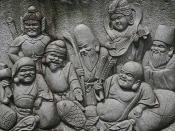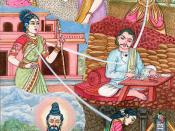There are four paths to "Brahman" in the Hindu religion. This sets it aside from most of the other religions around today. There are four basic spiritual personality types for which Hinduism gives a distinct yoga that focuses on the type's strong point. The point of the yogas is to reveal the underlying divinity in humans. These are the different paths to God.
Jnana yoga is the path to God through knowledge. This is for those who are thinkers. The Jnana strive to identify with God. It is an intuition within the seeker that they eventually become what they know. Once they grasp this point, their sense of self gets to a deeper level. There are three stages in grasping this power. There is Learning, Thinking, and shifting self-identification to the abiding part. These steps lead to "convincing the thinker that she possesses more than her finite self." Jnana yoga is said to be the shortest and "steepest path to divine realization."
Bhakti yoga is the path to God through love. It is the most popular of the four. All the basic principles of bhakti are shown in Christianity. People who are more in touch with their feelings than thoughts choose bhakti. In this yoga, you love God for love's sake alone. The bhaktas love and symbolize God in many ways. They practice this to strengthen their affection towards God and "weaken the world's grip." This yoga is where you see a lot of the different forms of God. The forms symbolize aspects of God and point to something beyond.
Karma yoga is the path to God through work. In humans, "The drive to work is psychological, rather than economic." This path expresses love through activity. The work approach can be intellectually or through the spirit of love. So...


